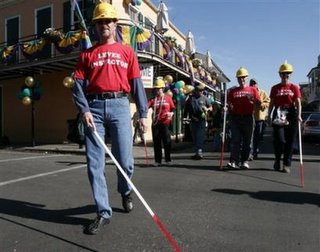You're so special we've made a podcast for you!
Disabled people can have fun too
They can do anything we can do
Say thank you to the BBC
Dry your eyes and listen in to people just like you!
Confined to a website....the Ouch! Podcast!
 This first BBC Ouch Disability Podcast includes a discussion of the Paralympics and other disability sports (Liz is annoyed that well-publicized athletic crips make her look like a slacker); a quiz called "Vegetable, Vegetable, or Vegetable," in which the hosts have 90 seconds to guess the disability of a listener on the phone (it ends with them assuring the listener that she is "very very brave and special"); an interview with John Davidson, a Scotsman whose life with Tourette's is about to be depicted in a motion picture; not to mention underwear, public restrooms, keys, pillows, Mat's tales of the All-Thalidomide Olympics...
This first BBC Ouch Disability Podcast includes a discussion of the Paralympics and other disability sports (Liz is annoyed that well-publicized athletic crips make her look like a slacker); a quiz called "Vegetable, Vegetable, or Vegetable," in which the hosts have 90 seconds to guess the disability of a listener on the phone (it ends with them assuring the listener that she is "very very brave and special"); an interview with John Davidson, a Scotsman whose life with Tourette's is about to be depicted in a motion picture; not to mention underwear, public restrooms, keys, pillows, Mat's tales of the All-Thalidomide Olympics...The Ouch! podcast is certainly "very very brave and special," but there are other disability-focused podcasts worth a listen. Blind audio bloggers are at the forefront here: David Faucheux's Blind Chance, BlindCoolTech, and the Blind Access Journal are just a few of the regularly updated podcasts with relevant and varied content. Disability411 is hosted by Beth Case, a disability counselor, and works more like an audio workshop on legal and policy topics of interest to folks in disability-related professions; a new English 'cast, Proud, Angry, and Strong, just started last month, but intends to focus on disability and arts topics (the host is an English singer-songwriter). Wish I understood French, because Handimobility looks like a killer Francophone podcast on disability topics. And David N. Wallace's Blobcast brings audio comment on disability from an Australian context.
Parenting podcasts are pretty common, and they're also represented in the universe of disability podcasts, mostly from parents raising kids with autism diagnoses, it seems: Autism Podcast is fairly new, with frequent tips and interviews with educators on communication, toilet training, getting services, etc. Autism Tales and Special Needs Stories collects "funny, strange, and heartwarming" contributions from parents across the US. The GROW podcast covers topics like child advocacy, IEPs, and family counseling. (Some readers of DS,TU may also want to look at the website for the Education Podcast Network--an effort to compile a comprehensive list of education podcasts. Could be a good model for similar efforts in other fields.)
There's an unfortunate phenomenon called podfading, where an ambitious plan for a regular podcast goes by the wayside, and we're left with just a few old episodes to enjoy. The sometimes raunchy Blind Kiss, produced by Ouch!'s Damon, posted its most recent episode a year ago (one show description includes "Sara tests Damon to see if he knows which celebrities are black and which are white")--go listen anyway, they're good; Marlaina by Ear seems to have last posted a new installment in December 2005; What Jake Thinks, a movie reviews podcast by a teenager with Angelman syndrome, seems to have been suspended for health reasons in recent months, but may yet return.
We'll check back on this rapidly growing format from time to time; if you hear (or produce!) a really great disability podcast, drop us a line.
I meant to add (3/31): For a lengthy but interesting discussion of the accessibility issues associated with iPods, check BlindConfidential and the continuation here. The author notes,
"I cringe every time I hear the term “Pod cast” on a blind person’s web site. Well before the iPod, an Apple trademark, we blinks enjoyed all kinds of streaming audio on the Microsoft platform...Why then do we insist on giving Apple a free advertisement for a product that might as well have a sign saying, 'No Blacks, No Dogs, No Irish' hanging on it as far as we blinks are concerned. I’m also dubious of anything containing the word “pod” that doesn’t refer directly to food...."Point taken. I tried to vary the nouns used in the post above, having read this, but it wasn't easy; I'm afraid that linguistic horse may already be out of the barn. See also Anna Dresner's new blog, NBP Book Updates, for discussions of iPod/iTunes accessibility.













